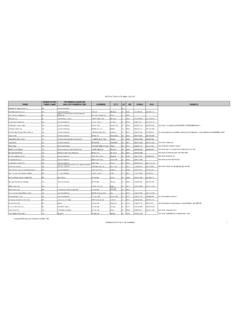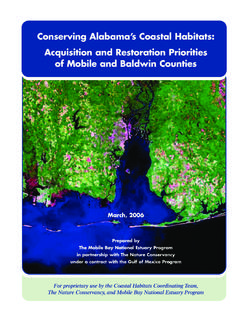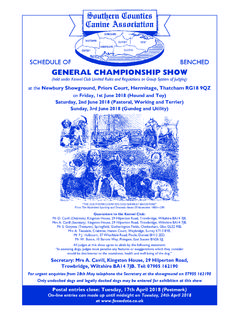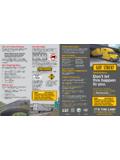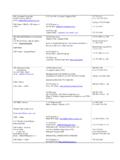Transcription of Meeting the Challenge of Invasive Plants: A …
1 Meeting the Challenge of Invasive Plants: A Framework for Actionprepared for the Michigan Department of Natural ResourcesWildlife Divisionby:Phyllis Higman & Suzan Campbell Michigan Natural Features Box 30444; Lansing, Michigan 48909-7944 Report Number 2009-11 March 9, 2009 Project CoordinatorsMark Sargent & Sue TangoraMichigan Department of Natural ResourcesWildlife DivisionAcknowledgementsSupport for this work was provided through a grant from the Michigan Department of Natural Resources, Wildlife Division. It was made possible by the determination of Project Coordinators, Mark Sargent and Suzan Tangora, to acknowledge and address the threat of Invasive plants throughout Michigan. They saw the project through from start to finish and facilitated interaction with the Wildlife Division Management Team and Field Staff, and multiple partners. We greatly appreciate their leadership, guidance, support and expertise. Thanks also to Ray Rustem, who supported the project at its inception and provided valuable information regarding the Invasive Species Advisory Council and related legislation.
2 We thank the many Wildlife Division staff and regional stakeholders who attended meetings, provided data, and supported this work. Particular thanks to Wildlife Division staff Terry Minzey, Brian Masten-brook, Sherry MacKinnon, Barb Avers, Ernie Kafkas, John Niewoonder, Michael Donovan, Brian Picco-lo, Matt Edson, Doug Pavlovich, Jon Curtis, Julie Oaks, Steve Griffith, John Schafer, and Vern Stephens; USFS staff Ian Shackleford, Greg Schmidt, Sue Trull, Jan Schultz and Alix Cleveland; Greg Corace of the USFWS and Miles Falck of the Great Lakes Indian Fish and Wildlife Commission. They provided sig-nificant distribution or research data and assisted us with mapping protocols and field surveys. Our MNFI colleagues Edward Schools and Helen Enander developed a field mapping tool and Kim Borland gathered abundant information on many Invasive work of Kate Howe of the Midwest Invasive Plant Network, Doug Pearsall, Ellen Jaquert, and others from The Nature Conservancy, David Mindell of PlantWise, Bill Schneider of WildType Native Plant Nursery, Sherri Laier of the Michigan Nature Association, Glenn Palmgren and Bob Clancy from Parks Division and Kim Herman of FMFM was instrumental in shaping the strategic approach and identifying Invasive plants of concern.
3 We appreciate our partnership with Doug Landis, Amos Ziegler, Rob Ahern to develop the Michigan Invasive Species Information Network (MISIN) and to move Invasive plant out-reach and education forward in Michigan. Thanks to Tony Reznicek, Beverly Walters and others at the University of Michigan Herbarium for access to voucher information and their keen knowledge of species distribution and ecology. We appreciate the strong support and expertise from Bob Heyd, Roger Mech, and Linda Lindberg from the Forest, Mineral and Fire Management Division, Lisa Brush of The Stewardship Network, Emily Finnell of the Michigan Department of Environmental Quality, and members of the Michigan and the Up-per Peninsula Invasive Plant Council. Thanks also to our other colleagues at Michigan Natural Features Inventory for their overall support. A special thank you to Ray Fahlsing, Dan Kennedy, Ryan O Connor, Kerry Fitzpatrick, and Chris Hov-ing for reviewing drafts of this approach and providing valuable advice and support on all aspects of this project.
4 Finally to all of you listed here or not, who have supported and will continue to shape this work and move it steadily forward thank you. We appreciate it greatly. iContentsExecutive Summary iiiI. Introduction 1II. Assessment and Development of Strategy 3 III. Impacts of Invasive Plants 5IV. Current Status of Invasive Plants in Michigan 9 Species of Concern and their Distributions ..9 Invasive Plants in Michigan s Ecoregions ..10 Regional Invasive Plant Lists ..12 Southern Lower Peninsula ..13 Northern Lower Peninsula ..14 Eastern Upper Peninsula ..15 Western Upper Peninsula ..16 Invasive Species Treatment Efforts and Information ..17V. Managing Invasive Plants 19VI. Vision for the Future 21 VII. A Strategic Approach 23 Guiding Principles ..24 Goals and Objectives ..25 Goal I: Leadership and Coordination Ensuring Cost Effective Action ..25 Goal 2: Assessment and Research The Pathway to Success ..26 Goal 3: Prevention The First Line of Defense ..27 Goal 4: Early Detection and Rapid Response The Second Line of Defense.
5 28 Goal 5: Control, Management, and Restoration The Third Line of Defense ..29 Goal 6: Education and Outreach Improving and Expanding Success ..30 VIII. Monitoring and Updates 31iiIX. Other State Programs 33X. Alternatives for Implementation 35XI. Appendices 37 Appendix A. Regional Meetings - Agenda and Notes ..39 Appendix B. County Distribution Maps ..53 Appendix C. Master List of Invasive Species ..59 Appendix D. Annotated Bibliography ..63 Appendix E. Key to Page Invasive Species Photos ..77iiiInvasive plants have been identified as a serious threat to biodiversity globally. Once established, they out-compete native species, reducing diversity and altering ecosystem structure, composition, and function. The changes result-ing from the most aggressive Invasive plants are occur-ring rapidly enough that they pose a serious and costly threat to wildlife in Michigan. To address this concern, Michigan Department of Natural Resources (MDNR) Wildlife Division contracted with Michigan Natural Features Inventory (MNFI) to assess the status of Invasive plants in Michigan and develop a strategy to address their negative impacts to wildlife.
6 MNFI reviewed herbarium data and literature, participat-ed in Invasive species symposia, consulted with national, state, and local resource professionals, and conducted statewide field surveys to assess which species pose the greatest threat and where they occur. They also reviewed current Invasive plant mitigation strategies to determine what actions have been most effective. Finally they held regional stakeholder meetings to gather input from staff and partners. Numerous Invasive plant species are well established in Michigan and spreading rapidly, however there is little current information on their distribution and abundance, and no official list of species that pose the greatest threat. Coarse scale surveys show that species of concern have colonized nearly every habitat type in Michigan and oc-cur in every county of the state. There are many efforts underway to address their impacts, however there is little statewide coordination or cost-benefit analyses for action and no centralized source of information to help guide state, regional, and local efforts.
7 There is clear consensus that as Invasive plant populations grow, the costs of treatment escalate, while the likelihood of successful mitigation declines. It is most cost effective to identify those species that pose the greatest threat to wild-life and direct actions towards prevention, early detection-rapid response, and control at prioritized sites. Using this tiered approach effectively requires an understanding of the most important places for supporting wildlife, the level of threat posed by the invader, the extent and abundance of the invader and effective control techniques and costs. Six strategic goals and associated objectives were identi-fied based upon the information gathered. The goals en-compass a central framework of prevention, early detec-tion-rapid response, and long-term control at strategically prioritized sites. They also include leadership to set direc-tion and empower staff, assessment and research to help identify winnable battles, and education and outreach to improve and expand success.
8 Four themes common to all the goals are presented as guiding principles. Preliminary lists of priority Invasive species, sorted into recommend-ed action categories are presented for Michigan s four major ecoregions to assist decision-making. Goal one calls for the designation of a Wildlife Division Invasive species coordinator and regional point staff to facilitate and coordinate action, assess progress, and set new priorities annually. Although this will require some resources and shifting of responsibilities, the approach presented is intended to maximize efficiency in the use of funds and staff time. Taking the time now to plan the pathway to success is important the longer coordinated and decisive action is delayed, the higher the ecological and socio-economic costs to wildlife will SummaryivGuiding Principles: Use of best available science and commitment to the integration of new information Prioritization of treatment based upon values, threat, distribution, and feasibility of control Collaboration with colleagues and partners to find opti-mal solutions and share resources, knowledge and skills Monitoring to ensure efficient and effective use of resources at all levels of organizationvGoal 6:Goal 5:Goal 4:Goal 3:Goal 2:Goal 1:objectivesobjectivesobjectivesobjectiv esobjectivesGoals and Objectives Leadership and Coordination ensuring cost effective action Facilitate the implementation of exemplary, science-based actions that eradicate or slow the establishment and spread of Invasive plants that pose a threat to wildlife in Michigan.
9 Designate an Invasive plants coordinator and regional point staff. Pursue and secure funding to address Invasive plants. Remove barriers to cross-jurisdictional action to facilitate rapid response and coordinated action. Influence state and regional policies that minimize the establishment and spread of Invasive plants. Work with other states to gather and share information on the risk and spread of Invasive and Research the pathway to success Assess the threat, status, and distribution of Invasive plants that negatively impact wildlife. Develop and maintain lists of high threat Invasive plants for targeted action. Establish centralized GIS-based database for mapping high-threat Invasive plants. Improve distribution maps for high-threat Invasive plant species. Use predictive modeling for high threat Invasive plant species. Promote research on ecological and economi impacts to plant communities and wildlife, control practices and detection techniques for Invasive plantsPrevention the first line of defensePrevent the introduction and establishment of high-threat Invasive plants at state, regional, and local levels.
10 Train staff on identification and best management practices. Identify and address entry points and pathways of spread. Adopt best management practices. Support policies and legislation that will minimize the impacts of Invasive Detection and Rapid Response the second line of defenseEnhance capacity to detect, report, and respond to newly detected introductions. Establish a reporting, verification, and alert system. Train staff and partners in early detection and rapid response. Develop rapid response and monitoring options for high-threat species. Establish response teams to conduct rapid assessment and treatment. Implement detection monitoring at strategic , Management, and Restoration the third line of defenseReduce the spread and harm caused by established Invasive plants. Develop manual of control practices for treating Invasive plants. Establish and implement processes for prioritizing action. Establish and implement protocols for documenting treatments and measures of success.











